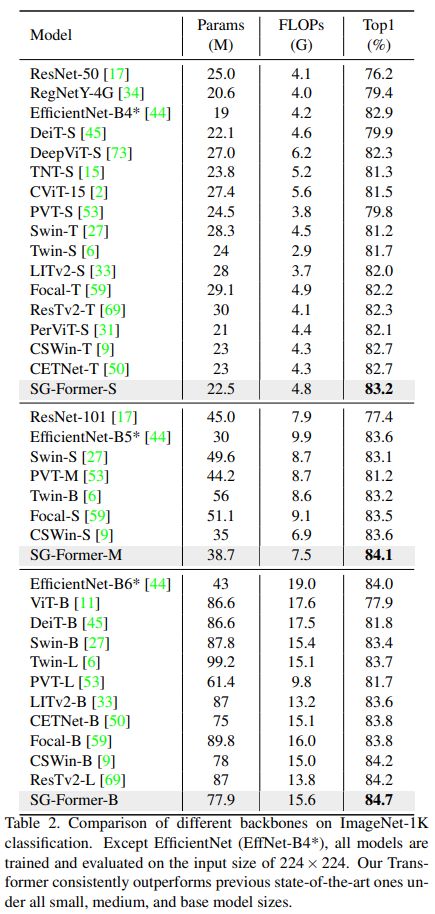SG-Former实战:使用SG-Former实现图像分类任务(一)
摘要
SG-Former是一种新型的Transformer模型,它被提出以降低视觉Transformer的计算成本,同时保持其优秀的性能表现。计算成本的降低使得SG-Former能够更有效地处理大规模的特征映射,从而提高了模型的效率和全局感知能力。
SG-Former的核心思想是利用显著性图来引导Transformer模型的学习。显著性图用于估计每个区域的重要性,从而可以根据这些重要性对Token进行重新分配。具体来说,对于显著区域,SG-Former会分配更多的Token,从而获得细粒度的注意力;而对于次要区域,SG-Former则会分配更少的Token,以换取效率和全局感知字段。

相较于以往的Transformer模型,SG-Former的创新之处在于其利用显著性图进行自适应细粒度全局自注意力的计算。这一改进降低了计算成本,同时提高了模型对大规模输入的适应性。此外,SG-Former还具有更少的参数数量和更高的效率,这使得它在各种视觉任务中具有广泛的应用前景。
在实验中,SG-Former在ImageNet-1K数据集上实现了84.7%的Top-1准确率,相较于Swin Transformer高出+1.3%;在COCO数据集上实现了51.2的mAP,相较于Swin Transformer高出+2.7 mAP;在ADE20K数据集上实现了52.7的mIoU,相较于Swin Transformer高出+3 mIoU。此外,SG-Former的计算成本也低于Swin Transformer。

这篇文章使用SG-Former完成植物分类任务,模型采用sgformer_s向大家展示如何使用SG-Former。由于没有使用预训练模型,sgformer_s在这个数据集上实现了89+%的ACC,如下图:
![]()
![]()
通过这篇文章能让你学到:
- 如何使用数据增强,包括transforms的增强、CutOut、MixUp、CutMix等增强手段?
- 如何实现SG-Former模型实现训练?
- 如何使用pytorch自带混合精度?
- 如何使用梯度裁剪防止梯度爆炸?
- 如何使用DP多显卡训练?
- 如何绘制loss和acc曲线?
- 如何生成val的测评报告?
- 如何编写测试脚本测试测试集?
- 如何使用余弦退火策略调整学习率?
- 如何使用AverageMeter类统计ACC和loss等自定义变量?
- 如何理解和统计ACC1和ACC5?
- 如何使用EMA?
如果基础薄弱,对上面的这些功能难以理解可以看我的专栏:经典主干网络精讲与实战
这个专栏,从零开始时,一步一步的讲解这些,让大家更容易接受。
安装包
安装timm
使用pip就行,命令:
pip install timm
mixup增强和EMA用到了timm
数据增强Cutout和Mixup
为了提高成绩我在代码中加入Cutout和Mixup这两种增强方式。实现这两种增强需要安装torchtoolbox。安装命令:
pip install torchtoolbox
Cutout实现,在transforms中。
from torchtoolbox.transform import Cutout
# 数据预处理
transform = transforms.Compose([
transforms.Resize((224, 224)),
Cutout(),
transforms.ToTensor(),
transforms.Normalize([0.5, 0.5, 0.5], [0.5, 0.5, 0.5])
])
需要导入包:from timm.data.mixup import Mixup,
定义Mixup,和SoftTargetCrossEntropy
mixup_fn = Mixup(
mixup_alpha=0.8, cutmix_alpha=1.0, cutmix_minmax=None,
prob=0.1, switch_prob=0.5, mode='batch',
label_smoothing=0.1, num_classes=12)
criterion_train = SoftTargetCrossEntropy()
参数详解:
mixup_alpha (float): mixup alpha 值,如果 > 0,则 mixup 处于活动状态。
cutmix_alpha (float):cutmix alpha 值,如果 > 0,cutmix 处于活动状态。
cutmix_minmax (List[float]):cutmix 最小/最大图像比率,cutmix 处于活动状态,如果不是 None,则使用这个 vs alpha。
如果设置了 cutmix_minmax 则cutmix_alpha 默认为1.0
prob (float): 每批次或元素应用 mixup 或 cutmix 的概率。
switch_prob (float): 当两者都处于活动状态时切换cutmix 和mixup 的概率 。
mode (str): 如何应用 mixup/cutmix 参数(每个’batch’,‘pair’(元素对),‘elem’(元素)。
correct_lam (bool): 当 cutmix bbox 被图像边框剪裁时应用。 lambda 校正
label_smoothing (float):将标签平滑应用于混合目标张量。
num_classes (int): 目标的类数。
EMA
EMA(Exponential Moving Average)是指数移动平均值。在深度学习中的做法是保存历史的一份参数,在一定训练阶段后,拿历史的参数给目前学习的参数做一次平滑。具体实现如下:
import logging
from collections import OrderedDict
from copy import deepcopy
import torch
import torch.nn as nn
_logger = logging.getLogger(__name__)
class ModelEma:
def __init__(self, model, decay=0.9999, device='', resume=''):
# make a copy of the model for accumulating moving average of weights
self.ema = deepcopy(model)
self.ema.eval()
self.decay = decay
self.device = device # perform ema on different device from model if set
if device:
self.ema.to(device=device)
self.ema_has_module = hasattr(self.ema, 'module')
if resume:
self._load_checkpoint(resume)
for p in self.ema.parameters():
p.requires_grad_(False)
def _load_checkpoint(self, checkpoint_path):
checkpoint = torch.load(checkpoint_path, map_location='cpu')
assert isinstance(checkpoint, dict)
if 'state_dict_ema' in checkpoint:
new_state_dict = OrderedDict()
for k, v in checkpoint['state_dict_ema'].items():
# ema model may have been wrapped by DataParallel, and need module prefix
if self.ema_has_module:
name = 'module.' + k if not k.startswith('module') else k
else:
name = k
new_state_dict[name] = v
self.ema.load_state_dict(new_state_dict)
_logger.info("Loaded state_dict_ema")
else:
_logger.warning("Failed to find state_dict_ema, starting from loaded model weights")
def update(self, model):
# correct a mismatch in state dict keys
needs_module = hasattr(model, 'module') and not self.ema_has_module
with torch.no_grad():
msd = model.state_dict()
for k, ema_v in self.ema.state_dict().items():
if needs_module:
k = 'module.' + k
model_v = msd[k].detach()
if self.device:
model_v = model_v.to(device=self.device)
ema_v.copy_(ema_v * self.decay + (1. - self.decay) * model_v)
加入到模型中。
#初始化
if use_ema:
model_ema = ModelEma(
model_ft,
decay=model_ema_decay,
device='cpu',
resume=resume)
# 训练过程中,更新完参数后,同步update shadow weights
def train():
optimizer.step()
if model_ema is not None:
model_ema.update(model)
# 将model_ema传入验证函数中
val(model_ema.ema, DEVICE, test_loader)
针对没有预训练的模型,容易出现EMA不上分的情况,这点大家要注意啊!
项目结构
Sgformer_Demo
├─data1
│ ├─Black-grass
│ ├─Charlock
│ ├─Cleavers
│ ├─Common Chickweed
│ ├─Common wheat
│ ├─Fat Hen
│ ├─Loose Silky-bent
│ ├─Maize
│ ├─Scentless Mayweed
│ ├─Shepherds Purse
│ ├─Small-flowered Cranesbill
│ └─Sugar beet
├─models
│ ├─pos_embed.py
│ └─sgformer.py
├─mean_std.py
├─makedata.py
├─train.py
└─test.py
models:来源官方代码,对面的代码做了一些适应性修改。
mean_std.py:计算mean和std的值。
makedata.py:生成数据集。
ema.py:EMA脚本
train.py:训练SG-Former模型
计算mean和std
为了使模型更加快速的收敛,我们需要计算出mean和std的值,新建mean_std.py,插入代码:
from torchvision.datasets import ImageFolder
import torch
from torchvision import transforms
def get_mean_and_std(train_data):
train_loader = torch.utils.data.DataLoader(
train_data, batch_size=1, shuffle=False, num_workers=0,
pin_memory=True)
mean = torch.zeros(3)
std = torch.zeros(3)
for X, _ in train_loader:
for d in range(3):
mean[d] += X[:, d, :, :].mean()
std[d] += X[:, d, :, :].std()
mean.div_(len(train_data))
std.div_(len(train_data))
return list(mean.numpy()), list(std.numpy())
if __name__ == '__main__':
train_dataset = ImageFolder(root=r'data1', transform=transforms.ToTensor())
print(get_mean_and_std(train_dataset))
数据集结构:
![]()
运行结果:
([0.3281186, 0.28937867, 0.20702125], [0.09407319, 0.09732835, 0.106712654])
把这个结果记录下来,后面要用!
生成数据集
我们整理还的图像分类的数据集结构是这样的
data
├─Black-grass
├─Charlock
├─Cleavers
├─Common Chickweed
├─Common wheat
├─Fat Hen
├─Loose Silky-bent
├─Maize
├─Scentless Mayweed
├─Shepherds Purse
├─Small-flowered Cranesbill
└─Sugar beet
pytorch和keras默认加载方式是ImageNet数据集格式,格式是
├─data
│ ├─val
│ │ ├─Black-grass
│ │ ├─Charlock
│ │ ├─Cleavers
│ │ ├─Common Chickweed
│ │ ├─Common wheat
│ │ ├─Fat Hen
│ │ ├─Loose Silky-bent
│ │ ├─Maize
│ │ ├─Scentless Mayweed
│ │ ├─Shepherds Purse
│ │ ├─Small-flowered Cranesbill
│ │ └─Sugar beet
│ └─train
│ ├─Black-grass
│ ├─Charlock
│ ├─Cleavers
│ ├─Common Chickweed
│ ├─Common wheat
│ ├─Fat Hen
│ ├─Loose Silky-bent
│ ├─Maize
│ ├─Scentless Mayweed
│ ├─Shepherds Purse
│ ├─Small-flowered Cranesbill
│ └─Sugar beet
新增格式转化脚本makedata.py,插入代码:
import glob
import os
import shutil
image_list=glob.glob('data1/*/*.png')
print(image_list)
file_dir='data'
if os.path.exists(file_dir):
print('true')
#os.rmdir(file_dir)
shutil.rmtree(file_dir)#删除再建立
os.makedirs(file_dir)
else:
os.makedirs(file_dir)
from sklearn.model_selection import train_test_split
trainval_files, val_files = train_test_split(image_list, test_size=0.3, random_state=42)
train_dir='train'
val_dir='val'
train_root=os.path.join(file_dir,train_dir)
val_root=os.path.join(file_dir,val_dir)
for file in trainval_files:
file_class=file.replace("\\","/").split('/')[-2]
file_name=file.replace("\\","/").split('/')[-1]
file_class=os.path.join(train_root,file_class)
if not os.path.isdir(file_class):
os.makedirs(file_class)
shutil.copy(file, file_class + '/' + file_name)
for file in val_files:
file_class=file.replace("\\","/").split('/')[-2]
file_name=file.replace("\\","/").split('/')[-1]
file_class=os.path.join(val_root,file_class)
if not os.path.isdir(file_class):
os.makedirs(file_class)
shutil.copy(file, file_class + '/' + file_name)
完成上面的内容就可以开启训练和测试了。